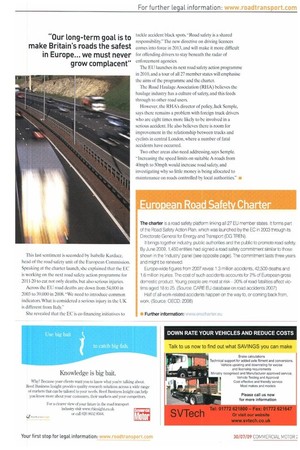Good news week
Page 26

Page 27

If you've noticed an error in this article please click here to report it so we can fix it.
Road death rates in the UK are falling faster than anywhere in Europe. Can a united Europe save a further 25,000 lives?
Words: Patric Cunnane
In these times of economic doom and gloom, good news is at a premium. However, in one very important area that affects everyone in the industry, there is something to shout about...
Britain's roads are getting safer. So much so that the UK is two years early in meeting its 2010 target of reduced deaths and injuries on its roads.
The target was part of the Road Safety Action Plan, which was launched by the European Commission in 2003 and has been superseded by this month's launch of the European Road Safety Charter which aims to save a further 25,000 lives.
Regrettable as all deaths and accidents are, this news is genuinely good. What's more, deaths involving HGVs are down by 40% from 2007 to 2008, the total number of road fatalities in the UK fell by 14% to 2,538% more than the EU average of 9% in the same period. That trend looks set to continue as provisional figures from September 2008 show a further 9% fail in UK fatalities, compared with the same period in 2007 Speaking at last month's launch of the charter, the minister responsible for road safety, Paul Clark MP, stressed the importance of pursuing road safety.
He said: "Our long-term goal is to make Britain's roads the safest in Europe. Most people have been affected by a road accident. We must never grow complacent; although deaths have fallen, people still lost their lives on Britain's roads last year. We need better education, enforcement and engineering."
Drugs and alcohol
Of the deaths that occur, a depressing 6`)/0 remain linked to alcohol, and the government is growing increasingly concerned about the number that may also be caused by drugs. For this reason, it is about to begin consultation on a new offence of driving while impaired and has mounted a summer campaign against drug driving.
Clark believes the government has got the balance right with enforcement, including extra funding for VOSA, and manufacturers seeing progress in making vehicles safer. "We need to turn to safer road engineering,said Clark. -Simple changes to road layout and design can inspire safety, so risk data is being gathered for all UK motorways. We can develop effective solutions by working together."
This last sentiment is seconded by Isabelle Kardacz, head of the road safety unit of the European Commission. Speaking at the charter launch, she explained that the EC is working on the next road safety action programme for 2011-20 to cut not only deaths, but also serious injuries.
Across the EU road deaths are down from 54,000 in 2003 to 39.000 in 2008. "We need to introduce common indicators. What is considered a serious injury in the UK is different from Italy."
She revealed that the EC is co-financing initiatives to tackle accident black spots. "Road safety is a shared responsibility." The new directive on driving licences comes into force in 2013, and will make it more difficult for offending drivers to stay beneath the radar of enforcement agencies.
The EU launches its next road safety action programme in 2010, and a tour of all 27 member states will emphasise the aims of the programme and the charter.
The Road Haulage Association (RHA) believes the haulage industry has a culture of safety, and this feeds through to other road users.
However, the RHA's director of policy, Jack Semple, says there remains a problem with foreign truck drivers who are eight times more likely to be involved in a serious accident. He also believes there is room for improvement in the relationship between trucks and cyclists in central London, where a number of fatal accidents have occurred.
Two other areas also need addressing, says Semple. -Increasing the speed limits on suitable A-roads from 40mph to 50mph would increase road safety, and investigating why so little money is being allocated to maintenance on roads controlled by local authorities."












































































































































